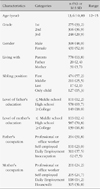Abstract
Purpose
The purpose of this study was to identify the relationship of self differentiation, self esteem and mental health in adolescents.
Methods
Data were collected from 829 adolescents and analyzed using descriptive statistics, t-test, ANOVA, Scheffe's test, Pearson correlation coefficients and multiple regression with the SPSS 14.0 program.
Results
Mental health differed according to grade, level of father's and mother's education. Self differentiation and self esteem had a significant negative correlation with mental health. Stepwise multiple regression analysis showed emotional cutoff, family projection, cognitive · emotional function, and family regression in self differentiation, self esteem, level of mother's education explained 24.4% of the total variance in mental health.
Figures and Tables
References
1. Baek CH. The effect of child-rearing and child respect of a mother on the child's depression. Seoul: Chongshin University;2006. Unpublished master's thesis.
2. Bowen M. Family theory in clinical practice. New York: Jason Aronson;1978.
3. Canetti L, Bachar E, Galili-Weisstub E, De-Nour AK, Shalev AY. Parental bonding and mental health in adolescence. Adolescence. 1997; 32:381–394.
4. Cho ES, Seo JM. Factors influencing children's mental health state. J Korean Acad Psychiatr Ment Health Nurs. 2010; 19:57–66.

5. Chong MR. The relationship between self differentiation and mental health according to adolescents development stages. Gwangju: Chonnam University;1994. Unpublished master's thesis.
6. Chung MJ, Yuh JI. Effects of individual and social factors on children's affective problems and self-worth. Korean J Child Stud. 2009; 30:71–82.
7. Cohen J. Statistical power analysis for the behavioral science. 2nd ed.Hillsdale, New Jersey: Lawrence Eribaum Associates;1988.
8. Derogatis LR. SCL-90-R: Administration, scoring & procedures manual-II for the revised version and other instruments of the psychopathology rating scale series. Towson, MD: Clinic Psychometric Research;1983.
9. Geun MY. The relationship between differentiation of self unadaptive behavior and problem behavior in adolescent. Sookmyung Women's University: Seoul;1993. Unpublished master's thesis.
10. Han SS, Kim KM. Influencing factors on self-esteem in adolescents. J Korean Acad Nurs. 2006; 36:37–44.

11. Je SB. The relationship between differentiation of self and dysfunction behavior: Based on Bowen's family system theory. Busan: Busan National University;1989. Unpublished doctoral dissertation.
12. Jeong SB, Kim SJ. A study on the relationship of family function and mental health of middle school students in a city. J Korean Acad Psychiatr Ment Health Nurs. 2001; 10:352–367.
13. Jeon BJ. Self-esteem: A test of its measurability. Yonsei Nonchong. 1974; 11(1):107–130.
14. Joo SH, Cho SW. Impact of conflict and nurturing factors for the divorced parents on the behavioral adaptation of their children. Korean J Soc Welf. 2004; 56:215–238.
15. Kang KA, Kim SJ, Song MK. Relationship of self-esteem, meaning in life, and spiritual well-being in middle school students. J Korean Acad Child Health Nurs. 2009; 15:343–349.

16. Kim CY, Jo HS. Self-differentiation, family function and stress level in high school students. J Korean Acad Child Health Nurs. 2008; 14:61–70.
17. Kim JH, Kim HJ, Son EK, Song YS, Jung IS. Child development psychology. Seoul: Dongmoonsa;2004.
18. Kim KI, Kim JH, Won HT. Symptom checklist procedure manual. Seoul: Chungang Jeoksung Publishing;1984.
19. Knauth DG, Skowron EA, Escobar M. Effect of differentiation of self on adolescent risk behavior: Test of the theoretical model. Nurs Res. 2006; 55:336–345.
20. Koh MS. Influence of parents' child rearing attitudes on family cohesion and self-esteem in adolescents. J Korean Acad Child Health Nurs. 2010; 16:195–202.

21. Lee HS. Effect of self differentiation and family function on mental health in adolescents. J Korean Acad Child Health Nurs. 2010; 16:297–303.

22. Nam SI. The relationship between the level of self-differentiation and the self-esteem among the adolescents. Soonchunhyang J Humanit. 2004; 12:77–91.
23. Ministry for Health Welfare and Family Affairs. 2007 Adolescents healthy behavior online investigation results. Seoul: Author;2008.
24. Nichols MP, Schwartz RC. Family therapy: Concept and methods. Boston: Allyn and Bacon;1991.
25. Park MH. The effects of family function perceived by adolescents on the feeling of social isolation and the stress coping behavior. Seoul: Sogang University;2008. Unpublished master's thesis.
26. Ringeisen H, Casanueva CE, Urato M, Stambaugh LF. Mental health service use during the transition to adulthood for adolescents reported to the child welfare system. Psychiatr Serv. 2009; 60:1084–1091.

27. Rosenberg M. Society and the adolescent self-image. Princeton, NJ: Princeton University Press;1965.
28. Rueter MA, Koerner AF. The effect of family communication patterns on adopted adolescent adjustment. J Marriage Fam. 2008; 70:715–727.

29. Seoul Child Young People Mental Health Center. 2006 Seoul child young people resources present condition. Seoul: Author;2006.
30. Wetzler S. Measuring mental illness: Psychometric assessment for clinicians. Washington, DC: American Psychiatric Press;1989.




 PDF
PDF ePub
ePub Citation
Citation Print
Print







 XML Download
XML Download